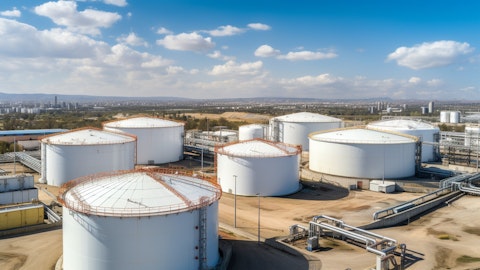DMC Global Inc. (NASDAQ:BOOM) Q1 2025 Earnings Call Transcript May 1, 2025
DMC Global Inc. beats earnings expectations. Reported EPS is $0.11, expectations were $-0.08.
Operator: Greetings and welcome to the DMC Global First Quarter 2025 Earnings Call. At this time, all participants are in a listen-only mode. A question-and-answer session will follow the formal presentation. [Operator Instructions] Please note, this conference is being recorded. I will now turn the conference over to our host, Geoff High, Vice President of Investor Relations. Thank you. You may begin.
Geoff High: Hello, and welcome to DMC’s first quarter conference call. Presenting today are DMC’s interim CEO, Jim O’Leary, and Chief Financial Officer, Eric Walter. I’d like to remind everyone that matters discussed during this call may include forward-looking statements that are based on our estimates, projections, and assumptions as of today’s date, and are subject to risks and uncertainties that are disclosed in our filings with the SEC. Our business is subject to certain risks that could cause actual results to differ materially from those anticipated in our forward-looking statements. DMC assumes no obligation to update forward-looking statements that become untrue because of subsequent events. Today’s earnings release and a related presentation on our first quarter performance are available on the Investor’s page of our website located at dmcglobal.com.
A webcast replay of today’s presentation will be available at our website shortly after the conclusion of this call. And with that, I’ll turn the call over to Jim O’Leary. Jim?
James O’Leary: Thanks, Geoff, and thanks to everyone for joining us today. Our first quarter was a solid start to 2025. Despite mounting external challenges, including tariffs, highly volatile and still softening macroeconomic conditions, and rapidly decreasing visibility into our core end markets, we still saw meaningful progress on our operational improvement initiatives. Consolidated first quarter sales were $159.3 million, up 5% sequentially, while adjusted EBITDA attributable to DMC was $14.4 million, 39% higher than the fourth quarter. At Arcadia, our architectural building products business, sales were $65.6 million, a 9% sequential increase and a 6% year-over-year improvement versus last year. Increased sales of commercial exterior storefront products and interior framing systems more than offset a planned for and expected decline in high-end residential window and door sales.
The back-to-basics initiatives we began implementing in recent months around renewed focus on Arcadia’s core commercial operations and a reinforced focus on cost containment contributed to improved year-over-year performance. DynaEnergetics, our energy products business, reported first quarter sales of $65.6 million, up 3% sequentially, and down 16% compared to the first quarter of last year. The year-over-year decline primarily reflects product pricing adjustments made in response to the downturn in Dyna’s core U.S. onshore energy market, where the number of active frac crews was down approximately 20% versus last year’s first quarter. A mild understatement would be that oil prices at current levels don’t enhance stability or confidence in Dyna’s core markets.
DynaEnergetics has responded by focusing on improving its operations and value engineering its product offerings. The new automated assembly lines at our manufacturing center in Blum, Texas, are now fully operational and expected to increase production capacity while supporting a leaner, more efficient workforce. We’re also seeing benefits from cost and efficiency improvements at our main product offering. Turning to NobelClad, our competent metal business, first quarter sales were flat sequentially, but up 5% year-over-year. Ongoing uncertainty around U.S. tariff policies and reciprocal actions has led customers to delay orders as they seek greater visibility. As a result, NobelClad’s order backlog at the end of the first quarter stood at $41 million, down from $49 million at the end of the fourth quarter.

Current floating activity indicates there’s pent-up demand for repair and maintenance work in NobelClad’s core downstream energy markets, and our manufacturing teams are ready to respond quickly when visibility improves and order volumes pick up. I’ll now turn the call over to Eric for a closer look at our first quarter results and our guidance for the second quarter. Eric?
Eric Walter: Thank you, Jim. I’ll start with a look at first quarter profitability. Consolidated adjusted EBITDA attributable to DMC was $14.4 million. Inclusive of the Arcadia non-controlling interest, adjusted EBITDA was $18.1 million, while adjusted EBITDA margin was 11.4%, up sequentially from 7.8% in the fourth quarter and flat with the prior year. The sequential increase was primarily driven by improved results at Arcadia and Dyna. Arcadia reported first quarter adjusted EBITDA attributable to DMC of $5.6 million. Before the non-controlling interest allocation, adjusted EBITDA was $9.3 million, or 14.2% of sales, up from 6.2% in the fourth quarter and 9.5% in the prior year first quarter. The improvement in adjusted EBITDA margin primarily related to better absorption of manufacturing costs.
Dyna delivered $7.4 million in adjusted EBITDA in the first quarter, up from $5.1 million in the fourth quarter. Adjusted EBITDA margin was 11.3%, which reflects an improvement of 325 basis points due to the launch of a second-generation DynaStage perforating system and the completion of a major automation initiative at Dyna’s manufacturing center in Blum, Texas. NobelClad reported first quarter adjusted EBITDA of $5.4 million, with an adjusted EBITDA margin of 19.2%, down from 20.6% in the fourth quarter and 21.9% in the prior year. The decline in first quarter in the first quarter was primarily due to a higher mix of sales from global projects, which typically carry a lower gross margin. First quarter SG&A expense was $28.3 million, up sequentially from $25.1 million in the fourth quarter and relatively flat with the 2024 first quarter.
The sequential increase reflects higher expenses for professional services, increased bad debt expense at Arcadia and Dyna, and a reset of incentive compensation to target levels across the businesses. First quarter adjusted net income attributable to DMC was $2.2 million, while adjusted EPS attributable to DMC was $0.11. With respect to liquidity, we ended the first quarter with cash and cash equivalents of approximately $15 million. Total debt, inclusive of debt issuance costs, was approximately $72 million, and net debt was roughly $58 million. Our debt-to-adjusted EBITDA leverage ratio was 1.38, which remains well below our covenant threshold of 3.0. On a proforma net debt basis, after subtracting cash, our leverage ratio at the end of the first quarter was 1.11.
And now on to guidance. At Arcadia, we anticipate lower project billings due to the completion of a substantial portion of a large mixed-use project in California. Additionally, Arcadia’s results are expected to be below the year-ago second quarter, which benefited from very strong demand for residential and commercial exterior products. Since last year’s second quarter, demand in the luxury residential market has declined significantly, reflecting persistently high interest rates, renewed inflation concerns, and broader macroeconomic uncertainty. For DynaEnergetics, second quarter guidance assumes sequentially stable well completion activity in its core U.S. onshore oil and gas markets. Finally, NobelClad sales are expected to slow sequentially as customers seek clarity on evolving U.S. and reciprocal tariff policies.
Based on these assumptions, we expect second quarter consolidated sales will be in a range of $149 million to $157 million, and adjusted EBITDA attributable to DMC will be in a range of $10 million to $13 million. I should note that our guidance is heavily influenced by macroeconomic concerns, volatility, and visibility issues created by current tariff policies and the current level of energy prices. It’s subject to change both upward or downward as greater clarity emerges. Now I’ll turn it back to Jim for some additional comments.
James O’Leary: Thanks, Eric. We ended 2024 by successfully extending the maturity of our Arcadia put-call arrangement and stabilizing operations across our business portfolio. We’re now entering 2025 focused on our primary near-term objectives, drive absolute EBITDA growth, generate strong free cash flow, and restore our balance sheet to full health through deleveraging over the coming quarters and year ahead. I want to thank our business leaders and the dedicated DMC associates around the world for their continued hard work and loyalty and for effectively executing our operating improvement strategies in what continues to be a very challenging environment. And with that, operator, we’d be glad to take any questions.
Q&A Session
Follow Dmc Global Inc. (NASDAQ:BOOM)
Follow Dmc Global Inc. (NASDAQ:BOOM)
Receive real-time insider trading and news alerts
Operator: Thank you. And at this time, we’ll conduct our question-and-answer session. [Operator Instructions] And our first question comes from Gerry Sweeney with Roth Capital Partners. Please state your question.
Gerry Sweeney: Good afternoon, Jim, Eric, Geoff. Thanks for taking my call.
James O’Leary: Yeah. Gerry.
Gerry Sweeney: Nice quarter. I’ll start with that. I did want to also just ask a question about guidance, but in a larger sort of frame. I’m just curious sort of what are the puts and takes behind the guidance, you know, maybe specifically any impact from tariffs, higher steel costs, et cetera, in some of your results. Sort of looking at the revenue and EBITDA, it looks like we’re sort of focusing in or implying a little bit of lower gross margin. So maybe frame that out a little bit better with guidance. How much is sort of tariffs, impacts and tariffs on calls versus maybe lower volumes and just end markets pricing because of tariffs?
James O’Leary: There’s a little bit in there for tariffs. If you look at what we were able to cover by pulling in inventory, some of our own mitigation strategies, this would be the least quarter going forward for the year that’s impacted by tariffs, just the timing of when they roll on. That ignores the fact that tariffs are creating demand disruption now. NobelClad, if you look at them last year where they had pretty much spectacular results all year, our comments on them having lower order intake, it obviously suggests they’re going to be a bit lower next year. That’s baked into the guidance for the rest of this year. And we specifically called out Arcadia, which is less impacted by tariffs than really any of our businesses.
It is impacted by interest rates where last year was really the last tour off of the residential business where we’ve had pretty significant pull in from, I’d say pull in a demand from strategies that the company had been employing since the acquisition. It led to a pretty strong quarter for the residential business at Arcadia. But if you look at, and the numbers aren’t out until Tuesday, but if you look at most of the home builders, if you look at Jeld-Wen last quarter, if you look at anybody in the construction business, interest rates hit the level they’ve been at for the past year, do impact demand a little bit, particularly on high-end residential. And that’s explicitly baked into our guidance. So a little bit tariffs, a lot of demand disruption.
And as Eric said, if the tariffs go away and demand picks up, they should be better. If they don’t, we could certainly be worse. But we’ve tried to explicitly factor in each one of those items. And a key takeaway would be this is probably the lightest tariff impact we’ll see in the quarter because of timing and because of some mitigation efforts we’ve been able to employ.
Eric Walter: Gerry, the other thing I would add to it is that we’re guiding to lower sales quarter over quarter, so there’s going to be a little less overhead absorption of manufacturing costs.
Gerry Sweeney: Yeah. That was sort of my next sort of implied question, but thanks. What about, obviously, your back-to-basics has been the mantra recently, right? And Dyna had a phase 1 automation process. You’re introducing DynaStage 2.0. There are some benefits there. And I think you also talked about an automation phase 2 at DynaEnergetics. And then as well as in Arcadia, you know, Jim Schladen just came back. Where are we in terms of additional opportunity taking costs out on both those segments? I think Dyna is probably a little bit further along, but I’m curious about Arcadia as well.
James O’Leary: Arcadia really is about fixing the residential business, refocusing on the commercial business. Jim is definitely focused on cost containment to a much greater extent than the company has been in the last couple of years. But are we in early innings? Probably, but we’re not going to quantify what the total impact would be. This is, you know, this isn’t a program. This is the way of life until we get the Arcadia put call taken care of.
Gerry Sweeney: Got it.
Eric Walter: Yeah, and I’d say, yeah, sorry, just to answer the question on the Dyna side. So we’ve had some impact in Q1 from the product reengineering that we referenced earlier. The automation is coming online in Q2. So we haven’t fully achieved all those savings. But the counterbalance to that is that the business is going to be impacted by tariffs. So it’s really hard for us to predict how much of those savings are going to fall to the bottom line.
Gerry Sweeney: If DynaStage 2.0 has a smaller form factor uses less steel, does that make you a little bit more competitive against competitors?
James O’Leary: It does. Well, yeah, it, you know, can’t comment on the supply chain for our competitors. But for Dyna, it definitely will help relative to what the product looked like this time last year. There’s just less steel to be subject to a tariff.
Gerry Sweeney: Yeah. I’ll jump back in queue. Thanks.
Operator: Your next question comes from Ken Newman with KeyBanc Capital Markets. Please state your question.
Ken Newman: Thanks. Good evening, guys.
James O’Leary: Hi Ken.
Eric Walter: Hi Ken.
Ken Newman: Eric. Hey, Eric, maybe for my first question. Is there any way you can help size up just how much the large California commercial project added to the first quarter EBITDA in Arcadia? And just trying to think about that sequential EBITDA margin for that segment at the midpoint of the 2Q guide. Do you think that business could still be profitable at the operating income level in 2Q? Just any help there would be appreciated.
Eric Walter: Yeah, I mean, that was the commercial side of our business. And, yes, it’ll be profitable in Q2. It’s the largest part of our business. We haven’t commented publicly on the size of that project, but it was a relatively large project for us, one of the larger one in the last two to three years that substantially is complete. So that’ll impact the top line. And then, obviously, that will impact EBITDA in Q2 as well.
Ken Newman: Okay. That’s helpful. And then, maybe circling back kind of to tariffs, but, obviously, we’re starting to see some maybe early signs of suppliers pushing price at the, up at the early end of the supply chain. I’m curious if you’re seeing any of that from your own suppliers. And what are you embedding for organic price this quarter and your ability to push price in the back half of the year?
Eric Walter: Yeah, it’s — we’re continuing to evaluate the supply chain really across all three of the businesses. I’d say it’s difficult right now to predict how we’re going to be able to impact that through the next quarter as well as the second half of the year. Certainly something we’re looking at, but really difficult to assess right now.
Ken Newman: Understood.
Operator: Thank you. [Operator Instructions] Our next question comes from Stephen Gengaro with Stifel. Please state your question.
Stephen Gengaro: Thanks, and good afternoon, everybody. Just a quick one to start. You had released something, I think, a couple weeks back on a tariff surcharge on the Dyna business. And I’m just curious how that has gone so far and just kind of what you’re seeing in the perf gun market as far as pricing is concerned, given some of the cross-currents we’re dealing with right now.
James O’Leary: We’ve had some success passing it along as a surcharge, not a 100%. We’re having discussions with a number of our customers about what the gain sharing or what the pain sharing is probably a better way to put it is going to be. And given how many private competitors we have and how visible our numbers are standalone in our financials, commenting on price increases isn’t a great policy for a company like us. So, we’re having some success passing the surcharge along, not total success. We’ve recovered part of it from the supply chain, thanks to partnership with our suppliers. And we’re still in discussions with some of our customers. But the guidance reflects more than 50% recovery of what we’ve got out there. And just as a policy matter, we’ve got it out there as a surcharge because when the tariffs go away, the surcharge goes away.
That way it’s not a – there’s no risk of it being permanently embedded in the eyes of our customers as a price increase. It’s really pain sharing.
Stephen Gengaro: Okay, that’s fair. And when we think about what we’re hearing from a lot of the upstream players and, you know, the crude price is obviously soft and we’re looking at kind of a second half. But at this point maybe it looks like it’ll be down somewhat in the year-over-year, North American activity probably down. How do you think the Dyna business performs in the second half of the year? I’m not asking you for guidance. I’m not asking you to set the parameters. But if rig count drops by 50 to 75 rigs over the next 12 months or next two to three quarters, do you think you’ll outperform? How do you think margins react? Like is there a way to frame it in that kind of a scenario?
James O’Leary: If oil stays in the 50s and rig count goes down, frac stages go down, obviously our business is going to be softer. Right now we’re expecting it to be flat to modestly down. Could be substantially worse if the end market is substantially worse.
Stephen Gengaro: Okay. And then one other quick one, and I imagine you won’t have a comment, but I get asked about this all the time. So I’m going to ask you, what’s going on with the whole Steel Connect situation? Is there any update you can give even at a high level?
James O’Leary: There are a larger shareholder. We have conversations with them periodically. And I think you find out contemporaneously, if not shortly thereafter, whenever they have a public release, which there hasn’t been in a while. So other than they’re our larger shareholder and we appreciate their patronage, there really is nothing to report.
Stephen Gengaro: Okay, great. Thank you for the color.
James O’Leary: You’re welcome, Stephen.
Operator: Thank you. And there are no additional questions at this time. So I’ll hand the floor back to Jim O’Leary, CEO, for any closing remarks. Thank you.
James O’Leary: Well, operator, thank you. And thanks for those of you who participated in the call today. We will talk again in a couple of months.
Operator: Thank you. And with that, we conclude today’s call. All parties may disconnect. Have a good day.
Follow Dmc Global Inc. (NASDAQ:BOOM)
Follow Dmc Global Inc. (NASDAQ:BOOM)
Receive real-time insider trading and news alerts





